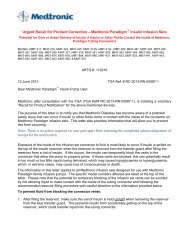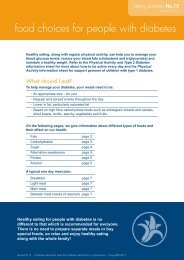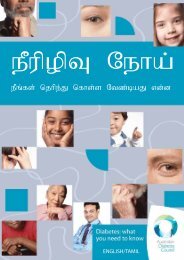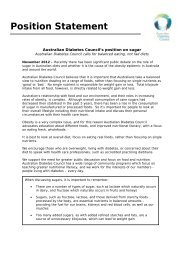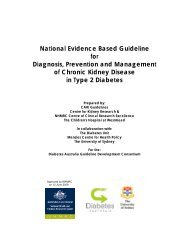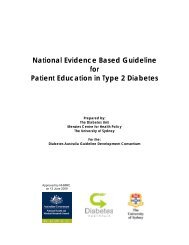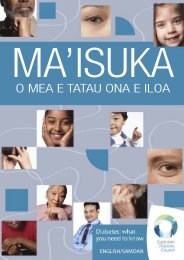Diabetes and Kidney Disease - Australian Diabetes Council
Diabetes and Kidney Disease - Australian Diabetes Council
Diabetes and Kidney Disease - Australian Diabetes Council
- No tags were found...
Create successful ePaper yourself
Turn your PDF publications into a flip-book with our unique Google optimized e-Paper software.
<strong>Diabetes</strong> <strong>and</strong><strong>Kidney</strong> <strong>Disease</strong>Management <strong>and</strong> prevention of kidneydisease in people with diabetes
<strong>Diabetes</strong> is a majorcause of kidneydisease in Australia.<strong>Kidney</strong> disease is a serious condition thatis often associated with other recognisedcomplications of diabetes, such as nerve damage,eye damage <strong>and</strong> cardiovascular disease. 5
Type 1 diabetes 3Type 2 diabetes 3Pre-diabetes 4Risk factors 5Maintaining a healthy weight 5What is BMI? 5What are the symptomsof diabetes? 5What does waistmeasurement indicate? 6What does my waistmeasurement mean? 6The role of the kidneys? 7What is chronic kidney disease? 9So what is the link betweendiabetes <strong>and</strong> kidney disease? 9Symptoms <strong>and</strong> signsassociated with kidney disease 9Treatment for kidney disease 10Managing blood glucose levels 11Maintaining a healthyblood pressure 11Maintaining healthylipid levels – cholesterol 13How much exercisedo you need? 14Managing levels of proteinin the urine (proteinuria) 15
Some 285 million peopleworldwide will live withdiabetes in 2010. 1It is predicted that by 2030 the number of peoplewith diabetes will have risen to 438 million. It is oneof the fastest growing chronic diseases worldwide. 1The good news is thattype 2 diabetes may beprevented or delayed.Several large scale studiesaround the world have shownthat regular physical activity <strong>and</strong>a healthy eating plan resultingin a small amount of weightloss can reduce the chance ofdeveloping type 2 diabetes byas much as 58 per cent. 2<strong>Diabetes</strong> is the name given toa group of conditions wherethere is too much glucose inthe blood. Glucose comes fromthe digestion of carbohydrates(such as bread, potatoes, rice,cereals, milk <strong>and</strong> fruit) <strong>and</strong> isthe body's main energy source.Insulin is a hormone producedby the pancreas which assiststhe glucose to enter the cells<strong>and</strong> be used as energy.1 <strong>Diabetes</strong> <strong>and</strong> <strong>Kidney</strong> <strong>Disease</strong>
Did you know:By 2031 it is estimated that3.3 million <strong>Australian</strong>s willhave type 2 diabetes, <strong>and</strong> ahigh proportion of this numberwill develop kidney failure. 5<strong>Diabetes</strong> <strong>and</strong> <strong>Kidney</strong> <strong>Disease</strong> 2
Type 1 diabetesType 1 diabetes occurs when thepancreas is unable to make insulinbecause the cells that make theinsulin have been destroyed bythe body’s own immune system.Type 1 diabetes is usuallydiagnosed during childhoodor young adulthood but canoccur at any age. At this time,people with type 1 diabetesrequire insulin by injectionor an insulin pump for life.Although type 1 diabetes cannot be prevented, managingdiabetes well, will preventlong term complicationssuch as kidney disease.Type 2 diabetesType 2 diabetes occurs whenthe insulin that is produced bythe pancreas does not do itsjob properly. This is referredto as insulin resistance. Intime, the pancreas may failto produce enough insulin toovercome the insulin resistance<strong>and</strong> type 2 diabetes occurs.Type 2 is the most common formof diabetes, affecting 85–90 percent of all people with diabetes.While it usually affects matureadults, more <strong>and</strong> more youngpeople, <strong>and</strong> even children,are being diagnosed. Type 2diabetes is managed by adoptinga healthy lifestyle which includeshealthy eating <strong>and</strong> regularphysical activity. Tablets <strong>and</strong>/orinsulin may also be required.3 <strong>Diabetes</strong> <strong>and</strong> <strong>Kidney</strong> <strong>Disease</strong>
Use the risk test ataustrali<strong>and</strong>iabetescouncil.com/whatismytype2riskto assess your risk of developingType 2 diabetes. If your score is over15 in the questionnaire, see yourGeneral Practitioner.The risk factors for developing type 2diabetes are:• A family history of type 2 diabetes• Age (over 55, or 45 withanother risk factor)• A history of high bloodpressure, high cholesterol<strong>and</strong>/or heart disease• Ethnic background – Chinese,Indian, Pacific Isl<strong>and</strong>er or Aboriginalor Torres Strait Isl<strong>and</strong>er• Having diabetes during pregnancy(gestational diabetes)• Having the condition PolycysticOvarian Syndrome (PCOS)Pre-diabetesPre-diabetes is a condition whereblood glucose levels are higher thannormal but not yet high enoughfor a diagnosis of type 2 diabetesThe risk factors for pre-diabetes arethe same as for type 2 diabetes.They include family history, inactivity<strong>and</strong> carrying excess weight aroundthe waistline. Being diagnosed withpre-diabetes does not necessarilymean a person will go on to developtype 2 diabetes. Lifestyle changessuch as weight loss, healthy eating,regular physical activity <strong>and</strong> stoppingsmoking will help to reduce the risk.• Having pre-diabetes (ImpairedFasting Glucose <strong>and</strong>/orImpaired Glucose Tolerance)• Being overweight, especiallyaround the waist• Doing little or no physical activity.<strong>Diabetes</strong> <strong>and</strong> <strong>Kidney</strong> <strong>Disease</strong>4
What are the symptomsof diabetes?In many cases type 2 diabetes hasfew or no symptoms. Often thesymptoms are thought to be relatedto age or tiredness <strong>and</strong> diabetes goesundiagnosed. Symptoms of type 2diabetes only develop when bloodglucose levels are high <strong>and</strong> may includethirst, blurry vision, skin <strong>and</strong> groinirritation, passing urine frequently,tiredness <strong>and</strong> slow healing cuts <strong>and</strong>abrasions. Remember, there may beno symptoms for type 2 diabetes in itsearly stages but a delay in the diagnosismay increase the risk of major healthproblems later on.Risk factors are divided into twocategories – those that you can change<strong>and</strong> those that you cannot.Risk factorsThere are some risk factors which youcan’t change or control. These are:• Age• Family history of type 2 diabetes• Ethnic background – Chinese,Indian, Pacific Isl<strong>and</strong>er or Aboriginalor Torres Strait Isl<strong>and</strong>er• Polycystic OvarianSyndrome (PCOS).However there are some risk factorsthat you can change. These include:• Maintaining a healthy weight• Making lifestyle changes• Following a healthy eating plan• Doing regular physical activity• Having regular health checks.Maintaining ahealthy weightExcess weight will affect bloodpressure, blood fats (cholesterol)<strong>and</strong> blood glucose levels. Ask yourtreating medical team if you are withinyour healthy weight range. This canbe done by calculating your BMI.What is BMI?Body Mass Index (BMI) is your weightdivided by your height squared. Itis an approximate measure of yourlevel of body fat but it is useful forcomparing your body compositionto the rest of the population. It canbe a useful predictor of your risk ofdeveloping chronic diseases such asheart disease, type 2 diabetes <strong>and</strong>high blood pressure (hypertension).A BMI of 18.5–25kg/m2 is consideredwithin the healthy weight range.Be aware that BMI varies fordifferent population groups.5 <strong>Diabetes</strong> <strong>and</strong> <strong>Kidney</strong> <strong>Disease</strong>
My waistcircumference is:What does waistmeasurement indicate?Distribution of body fat aroundthe waist, or your typical 'potbelly', is associated with anincreased prevalence of type 2diabetes, cardiovascular disease(heart <strong>and</strong> blood vessels disease),high cholesterol (blood fats) <strong>and</strong>hypertension (high blood pressure). 4Take a tape measure <strong>and</strong> measurearound your waist at the point of thebelly button. Then fill in your waistcircumference in the box above.What does my waistmeasurement mean?The waist measurements below(no matter what your height is)suggest that you have an increasedrisk of developing diabetes orcardiovascular disease. These arethe recommended measurementsfor Caucasian men <strong>and</strong> women<strong>and</strong> Asian women. 4Increased riskMen: more than 94cmWomen: more than 80cmGreatly increased riskMen: more than 102cmWomen: more than 88cm<strong>Diabetes</strong> <strong>and</strong> <strong>Kidney</strong> <strong>Disease</strong>6
<strong>Diabetes</strong> <strong>and</strong>chronic kidney disease –the link.<strong>Kidney</strong> disease is a complication of diabetes <strong>and</strong>diabetes is a leading cause of chronic kidney disease.The role of the kidneys?The role of the kidneys is to actas the body's filter <strong>and</strong> removewaste from the blood <strong>and</strong>eliminate it in the urine. Thecleaned blood then returns to thebody <strong>and</strong> continues to circulate.The kidneys also maintain thecorrect balance of salts <strong>and</strong> acidsin the body <strong>and</strong> produce certainhormones. Each day the kidneysfilter up to 200 litres of blood <strong>and</strong>produce about 1500–2000mlof urine. Urine contains all thewaste products <strong>and</strong> fluid <strong>and</strong>is needed to maintain a steadystate for the rest of the body.UnfilteredBlood InFilteredBlood OutUnfilteredBlood InFilteredBlood OutUrine OutUrine OutOneNephron7 <strong>Diabetes</strong> <strong>and</strong> <strong>Kidney</strong> <strong>Disease</strong>
Did you know:People who are obese areup to 3.2 times more likelyto develop type 2 diabetes.The only way that diabetes isdiagnosed is by a blood test.<strong>Diabetes</strong> <strong>and</strong> <strong>Kidney</strong> <strong>Disease</strong>8
What is chronickidney disease?Chronic kidney disease is the lossof over a third of your kidneyfunction for over three months.eGFR st<strong>and</strong>s for 'estimated glomerularfiltration rate'. eGFR is the bestmeasure of kidney function <strong>and</strong> helpsto determine the stage of kidneydisease. It shows how well the kidneysare cleaning the blood. A normaleGFR is greater than 90mL/min. 5So what is the link betweendiabetes <strong>and</strong> kidney disease?<strong>Diabetes</strong> is a major cause of kidneydisease in Australia. The kidneysare made up of around one millionnephrons. The nephrons act as thefiltering units inside the kidneys.Uncontrolled or poorly manageddiabetes can damage these filters<strong>and</strong> result in kidney disease (diabeticnephropathy). This kidney diseaseis a serious condition that is oftenassociated with other recognisedcomplications of diabetes, suchas nerve damage (neuropathy),eye damage (retinopathy) <strong>and</strong>cardiovascular (heart) disease. 5Symptoms<strong>and</strong> signsassociated withkidney disease• Proteinuria – increased proteinor albumin in the urine• Increasing blood pressure• Changes in volume <strong>and</strong>frequency of passing urine• Blood in the urine• Tiredness• Loss of appetite• Nausea <strong>and</strong> vomiting• Puffiness• Pain in the kidney area• Lack of concentration• Itching• Shortness of breath9 <strong>Diabetes</strong> <strong>and</strong> <strong>Kidney</strong> <strong>Disease</strong>
Did you know:<strong>Diabetes</strong> is the leading causeof kidney failure, accountingfor 30 per cent of new dialysispatients. Twenty years ago type2 diabetes accounted for only 2per cent of new dialysis patients. 5Treatment for kidney diseaseSometimes kidney disease leads tokidney failure. The treatment forkidney disease can be dietary changes<strong>and</strong> medication as well as dialysis ortransplantation. Dialysis removes wasteproducts from the blood when thekidneys fail. There are two forms ofdialysis – haemodialysis <strong>and</strong> peritonealdialysis. During haemodialysis, amachine acting as an artificial kidneycleans the blood. Haemodialysis canoccur either in hospital or 'satellite'unit or in some cases in the home.On average this process takes up to4–5 hours <strong>and</strong> is done 3–4 timesper week. Dialysing at home meansthat you can choose to dialyseduring the day or in the evening, <strong>and</strong>sometimes overnight while asleep,however this method will not besuitable for everyone. In peritonealdialysis (PD), dialysis fluid is movedin <strong>and</strong> out of the peritoneal cavityto remove wastes <strong>and</strong> fluid fromthe blood. It is usually performed athome. Short–term training is needed<strong>and</strong> this is organised by your healthcare team. A family member canalso receive training to help you.The choice between haemodialysis<strong>and</strong> peritoneal dialysis dependson many factors including:• Personal preference• Health <strong>and</strong> medical suitability• Lifestyle• Availability of resources• Finances e.g. travel costs.Transplantation is a treatment forkidney failure but is not a cure.The new transplanted kidneyrequires a lifetime of care <strong>and</strong>anti –rejection medication. 5<strong>Diabetes</strong> <strong>and</strong> <strong>Kidney</strong> <strong>Disease</strong> 10
What is the bestway to avoid kidneydisease in diabetes?To find early kidney disease in people with diabetes,an annual test of the urine <strong>and</strong> blood by your doctoris necessary. Once kidney disease is found muchcan be done to slow down or stop the progressioninto kidney failure that would otherwise occur.To prevent damage to thekidneys there are many thingsthat can be done, including:Managing bloodglucose levelsHyperglycaemia, or raised bloodglucose levels, can damage thesmall blood vessels in the kidneyscausing kidney damage. Managingblood glucose levels can slow theprogression of diabetic kidneydisease. The recommendedblood glucose levels are 6–8mmol/L before meals <strong>and</strong> 6–10mmol/L two hours after a meal. 6Maintaining a healthyblood pressureHigh blood pressure can causekidney damage <strong>and</strong> the higher itgets the more damage it can doto the kidneys. You can manageyour blood pressure by healthyeating, particularly a diet low insalt, weight loss, exercise, stressmanagement <strong>and</strong> medicationsprescribed by your doctor. Therecommended blood pressurelevel is below 130/80 for peoplewith diabetes <strong>and</strong> below 125/75in the presence of proteinuria.11 <strong>Diabetes</strong> <strong>and</strong> <strong>Kidney</strong> <strong>Disease</strong>
Did you know:By 2031 it is estimatedthat 3.3 million <strong>Australian</strong>swill have type 2 diabetes,<strong>and</strong> a high proportionof this number willdevelop kidney failure. 5<strong>Diabetes</strong> <strong>and</strong> <strong>Kidney</strong> <strong>Disease</strong> 12
Maintaining healthy lipidlevels – cholesterolStudies have shown that highcholesterol levels can increasethe progression of diabetic kidneydisease. Cholesterol <strong>and</strong> triglyceride(blood fat) levels can be managedby either dietary modificationsor medication if necessary.The recommendedblood fat levels are:cholesterolmmol/LTotal
How much exercise do you need?Gradually build up to a minimum of 210 minutes per week or 30 minutes everyday of the week. You can break the 30 minutes into shorter chunks as long asit lasts a minimum of 10 minutes per bout. If possible try not to go more thantwo days without exercising. Your 210 minutes per week should include:• Aerobic physical activitysuch as walking, jogging,swimming, cycling or dancing.• Resistance exercise (musclestrengthening) including: 8–10different exercises covering allmajor muscle groups (arms, legs,chest, back <strong>and</strong> abdominals),-3 sets of 8–10 repetitions.When starting out, try theexercises using lighter weights.As you get stronger <strong>and</strong> moreconfident, work your wayup to a weight that is toughto lift more than 10 times.• Incidental activity is anothergreat way to do more activitywithout trying very hard. Itis the activity you already doday to day. However, adding alittle extra or changing thingsslightly is one way to boostthe benefits to your health.• Take the stairs• Park further away atsupermarkets• Leave the TV remote nearthe TV (making you get upto change the channel!)<strong>Diabetes</strong> <strong>and</strong> <strong>Kidney</strong> <strong>Disease</strong>14
Managing levels of proteinin the urine (proteinuria).There are two types of medicationthat can be used to reduce theamount of protein in the urine. Theseare angiotensin–converting enzyme(ACE) inhibitors <strong>and</strong> angiotensinreceptor blockers (ARB). Yourtreating doctor might discuss withyou the use of these medicationsto reduce the amount of protein inyour urine. Any treatment that canlower this can help to reduce the rateof progression to kidney failure. 5Here are some tips to helpmeet the above goals• Adopt a healthy eating planincluding a low saturated fat diet.This means minimising fats fromanimal sources, such as butter,fatty meats <strong>and</strong> full fat dairyproducts, as well as the vegetablefats in commercially bakedproducts, coconut <strong>and</strong> palm oil. 7• Choose mainly low GlycemicIndex (GI) foods. These includeheavy grained breads, oats,untoasted muesli, pasta, Basmatior Doongara rice, corn, sweetpotato, baked beans, lentils <strong>and</strong>most other legumes, most fruits,<strong>and</strong> low fat milks <strong>and</strong> yoghurt.• Be physically active <strong>and</strong> lose someweight. These are important waysto help improve your blood fats.• Medications to lower cholesterol<strong>and</strong> triglyceride levels may alsobe required. There are differentmedications, called statins,cholesterol absorption inhibitors<strong>and</strong> fibrates, which targetdifferent blood fat problems. 5• Choose foods low in salt. This canbe done by reducing your intakeof processed foods, reading foodlabels <strong>and</strong> selecting products thathave less than 450mg of sodiumper 100g, <strong>and</strong> by not adding saltto your cooking or at the table. 715 <strong>Diabetes</strong> <strong>and</strong> <strong>Kidney</strong> <strong>Disease</strong>
Next time you visit your doctor:Ask your doctor as a part of your health check to test your:Blood pressureUrine for proteineGFR via a blood test.For more information about diabetes <strong>and</strong> managing your complications,please contact <strong>Australian</strong> <strong>Diabetes</strong> <strong>Council</strong> on 1300 DIABETES, or visitthe website australi<strong>and</strong>iabetescouncil.comFor more information about kidney health, please contact <strong>Kidney</strong> HealthAustralia on 1800 4 KIDNEY (1800 4 543 639) or visit kidney.org.au.References1. International <strong>Diabetes</strong>Federation. <strong>Diabetes</strong> Atlas. 4thed. Brussels: IDF, 2009.2. <strong>Diabetes</strong> Prevention ProgramResearch Group. Reduction in theIncidence of Type 2 <strong>Diabetes</strong> withLifestyle Intervention or Metformin.N Eng J Med. 2002; 346: 393-403.3. <strong>Australian</strong> Bureau of Statistics.National health survey: Summaryof results 2004–2005. Canberra:Commonwealth of Australia,2006. Available from:http://www.ausstats.abs.gov.au/Ausstats/subscriber.nsf/0/3B1917236618A042CA25711F00185526/$File/43640_2004-05.pdf4. <strong>Australian</strong> Government. Timeto take some healthy measure?How do you measure up?Canberra: Commonwealth ofAustralia, 2007. Available from:http://www.measureup.gov.au/internet/abhi/publishing.nsf.5. <strong>Kidney</strong> Health Australia. <strong>Diabetes</strong><strong>and</strong> chronic kidney disease [documenton the internet]. Australia: 2008.[updated April 2010]. Available from:http://www.kidney.org.au/ForPatients/<strong>Diabetes</strong><strong>and</strong>CKD/tabid/704/Default.aspx6. Colagiuri S, Dickinson S, GirgisS, Colagiuri R. National EvidenceBased Guideline for Blood GlucoseControl in Type 2 <strong>Diabetes</strong>.Canberra: <strong>Diabetes</strong> Australia <strong>and</strong>the NHMRC, 2009. Available from:http://www.diabetesaustralia.com.au/PageFiles/763/BGC%20guideline%20FINAL%20-%20Sept%202009.pdf7. <strong>Australian</strong> Government NationalHealth <strong>and</strong> Medical Research<strong>Council</strong>. Dietary Guidelines for<strong>Australian</strong> Adults. Canberra:Commonwealth of Australia, 2003.<strong>Diabetes</strong> <strong>and</strong> <strong>Kidney</strong> <strong>Disease</strong>16
<strong>Diabetes</strong> Australia – New South Walest/a <strong>Australian</strong> <strong>Diabetes</strong> <strong>Council</strong>Street address26 Arundel StreetGlebe NSW 2037Customer Care Line1300 diabetes1300 342 238ABN 84 001 363 766 Charity No. CFN12458© 2010 <strong>Australian</strong> <strong>Diabetes</strong> <strong>Council</strong>. May not bereproduced in whole or in part without prior permission.Postal addressGPO Box 9824Sydney NSW 2001Fax+61 2 9660 3633australi<strong>and</strong>iabetescouncil.com1800 4 kidney1800 4 543 639





